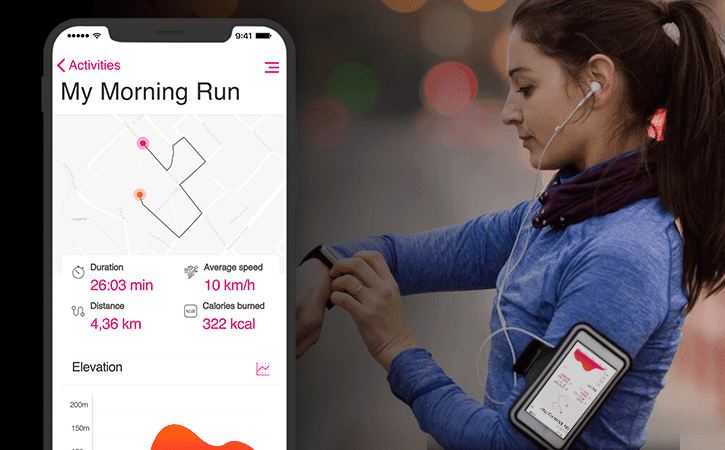Health and Fitness App Development: Tips to Build A Custom Fitness App

The advantages of regular physical activity are difficult to overstate. Exercise is well known for its ability to help people stay fit. Live a healthier lifestyle, boost energy levels, and improve resilience. However, getting them to participate in a fitness regimen can still be difficult. It is often the result of a lack of interest, motivation, or time. Fortunately, technological advancements have resulted in novel approaches to this problem. An effective fitness app may serve as a great motivator for users to exercise whenever and wherever they want.
Fitness applications are really popular right now. Fitness applications have become a fixture in practically every smartphone as more individuals pay more attention to their fitness and well-being. The health and fitness tracking application development has been intensified by COVID-19. With the lack of access to gyms and in-person training, many are turning to virtual classes to stay fit and motivated. This article will show you how to design a fitness app that meets both the demands of the user and the needs of the company.
Why would you develop a Fitness app?
According to research released in January 2019 by Market Watch, the fitness app market is anticipated to reach $14.7 billion by 2026. Over the forecast period, the market is anticipated to grow at a CAGR of 23%. The Fitness industry generated $17,963 million in sales in 2020, according to Statista, and it has continued to grow significantly.
The revenue is predicted to grow at a CAGR of 5.0 percent between 2019 and 2023, culminating in a market volume of $20,499 million. As a result, the fitness application market is likely to rise as new health and fitness features emerge.
According to Statista, 593 million health and fitness applications were downloaded globally in the first quarter of 2020. By the end of the second quarter of 2020, health and fitness applications are predicted to have 656 million downloads.
Types of health and fitness app
There are several health and fitness applications accessible, which you may make with the assistance of the superior technology that is now available to us. Following are some popular apps:
Activity Tracking App
This app serves as a tracker for certain functions, such as eating habits. Users will log what they consume, and the app will calculate the number of calories in the meals they’ve recorded. This program also allows you to keep track of your water consumption. A barcode scanner might be useful in this sort of software to assist communicate nutritional value information about the food item.
Nutrition and diet apps
This type of application will keep track of the numerous activities or workouts in which a user decides to engage. Depending on the activity, some apps are designed particularly for runners, bikers, and fitness monitoring. During activities, the app tracks the distance traveled, the number of steps walked or climbed, and the calories expended.
Workout fitness app
Application of this kind serves as a personal trainer or a clone of a gym or workout studio. It provides you with a specific training regimen or activity to help you achieve your fitness objectives, whether you desire to grow muscle or reduce weight. Users may select the body area they wish to concentrate on, such as Full Body, Upper Body, Core Strength, Lower Back, or even design a program.
Yoga & Meditation apps
Yoga and meditation apps often feature a laid-back and calming user interface since the activities they cover have an impact on your physical and mental wellness. Nonetheless, they function similarly to workout applications. Depending on their needs, users may select from a variety of courses and mentors.
Top Features in Fitness App Development
To stand out from the competition and attract more people, you must offer some amazing features. Following are some of the unique Features for Health and Fitness Apps:
Customise personnel profile
The user interface is a key consideration when creating a personalised fitness app. You may customize by entering specific metrics such as weight, activity level, and other variables.
3rd Party Device Connectivity
Allow your fitness app development services to measure the performance of their web content across several devices and evaluate traffic and demographics all from inside the same app platform.
User Activity Tracking
With a self-hosted online fitness class platform, you can collect detailed information about your users, such as their preferences, engagement rate, viewing sessions, and geo-location.
Geolocation Strategy
Insightful analytics such as IP geolocation inside a single analytical dashboard can assist you in tracking routes, analysing trip lengths and slopes, and improving micro-targeting.
Instructions and Tutorials
You may utilise instructional videos or tutorials to communicate with your consumers in real-time and share diet charts with them. You can also showcase some of your creative fitness workouts this way.
Social media Integration
Social media sites might be a great way to grow your user base. As a result, make sure your chosen fitness videos are socially engaged to encourage interaction.
Tips To Build a Custom Fitness App
1. Select your health and fitness app type
Start by categorising your ideas according to the list we’ve provided above to come up with a fresh proposal that will stand out among competitors. Keep in mind that your response should not be crammed into a small box.
2. Decide on platforms and technologies
When it comes to health and fitness solutions, smartphone applications make the most sense. To figure out which mobile platform to focus on, start by analysing your target demographic. If you want to cater to the needs of both Android and iOS customers, you may design a native app for each platform or two native applications. You can also go for cross-platform mobile development to save time and money.
3. Define important features
We’ve already covered the most important features for health and fitness apps. However, depending on the specifics of your app and the expectations of your target audience, you should research and test some additional features. Follow the lean methodology to ensure that you only invest in the features that your consumers require.
4. Choose a suitable monetization model
There are various methods to monetize health and fitness applications, including:
Subscription– This is the most common monetization approach since it allows customers to pay a charge to access all of the offered services for a year.
In-app ads– This is another approach to generate revenue, but keep in mind that you should only show relevant advertising to your consumers. Otherwise, they may uninstall your app. Collaboration with health and fitness businesses are a good fit for health and fitness applications.
Fees– If you want to create your own fitness app and connect with online fitness trainers who have prospective consumers, you could charge a modest fee for each user who uses your platform to access a training module.
5. Find a tech partner
When you work with an experienced tech vendor, your health app development will be easy and risk-free. Ask your health app developers to show you their portfolio and explain to you about the projects they’ve completed in the medical, athletic, and healthcare industries.
Key benefits of health and fitness apps
There are several reasons why you should use a health and fitness app. The following are some benefits of health and fitness mobile apps.
Individually Customized Goals
One of the best features of health and fitness applications is the ability to set goals that are specific to your requirements. The objectives that experienced athletes set for themselves will be considerably different from the ones that a novice sets for themselves, depending on their strength, experience, state of health, and desire. The wonderful thing about most health and fitness applications is that you can input your particular health information and be given personalised suggestions to follow.
You Can See and Track Your Progress
Seeing progress is perhaps the most difficult aspect of making health and fitness goals. When you begin a new healthy habit, it may take some time before you notice a physical change. You will be able to visibly observe your progress and improvement as you create and achieve objectives with health and fitness applications. Many individuals find it highly motivating to be able to view this information graphically on an app.
Health status Monitoring
Monitoring health status appears to be simple with health and fitness apps. They can readily monitor things that you would be unable to track on your own. Many fitness and health apps include monitoring/tracking capabilities such as heart rate tracking, weight loss progression, daily footsteps, how far you’ve traveled, your average running speed, healthy meal plans, calorie counter for daily intake, sleep tracker, learn the habits of your daily routine, and more.
Receive Free Health and Fitness Tips
Many fitness and health apps provide suggestions as well as monitoring and goal-setting features. These health and fitness suggestions are frequently sent in the form of articles. Daily alerts, calendar updates, or event invitations to join a community of users who are also using the app and discussing their experiences.
Monitor Your Diet Every Day
Everyone who wants to stay fit must adhere to a strict diet. Your app can track your calorie and nutrient intake based on the foods you eat throughout the day and night.
Key Takeaway
Health and fitness applications are becoming increasingly popular, as evidenced by the fact that there were 9000+ fitness apps in 2019, and the number of apps is rapidly expanding. And the apps range from nutrition apps to fitness training apps, all of which have been brilliantly built by health and fitness app development companies, making them more intuitive and engaging, rich in features, and most importantly, saving the health and lives of millions.




